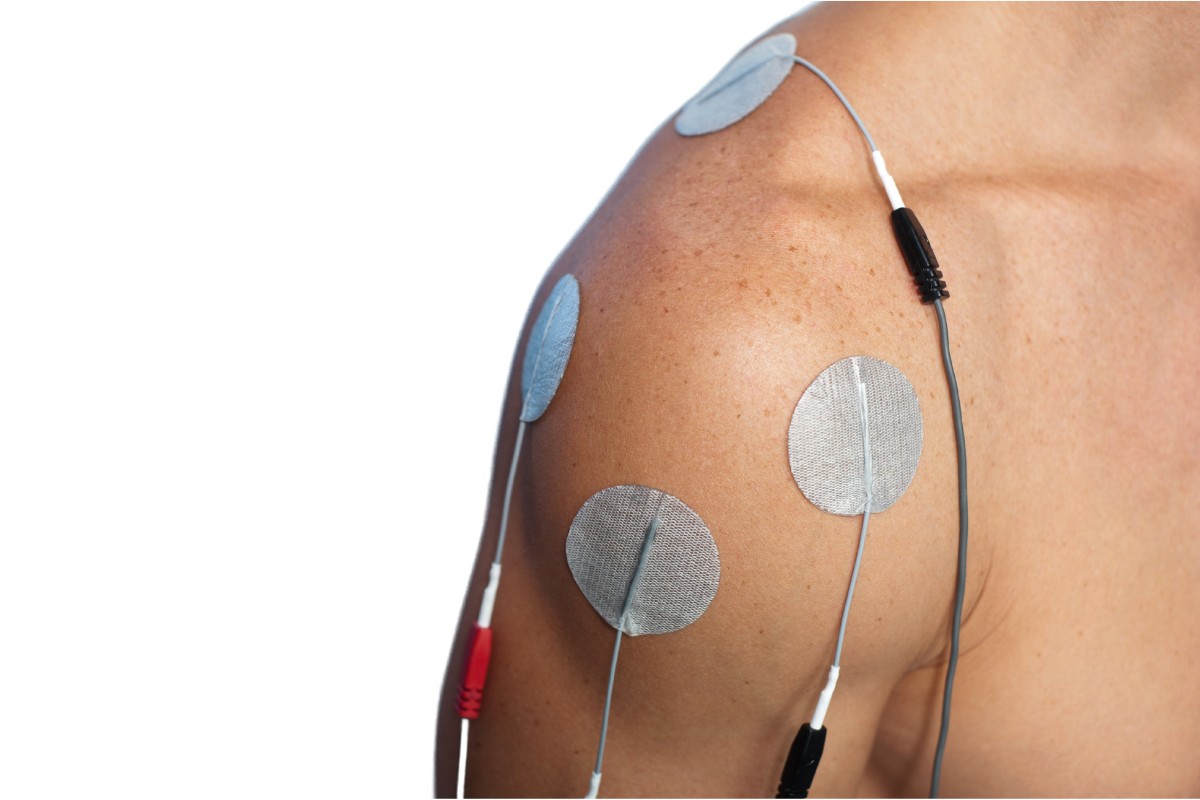TENS technology (transcutaneous electrical nerve stimulation) is an innovative method of relieving pain. This technique involves using electrical impulses to stimulate the nerves and reduce the pain felt. Since its introduction decades ago, TENS has become increasingly popular. It is used to relieve both chronic and acute pain. In this article, we will explore the different aspects of TENS technology, its benefits and how it can be used to improve the quality of life of people suffering from chronic or acute pain.
What does TENS stand for & what is it used for?
TENS stands for transcutaneous electrical nerve stimulation. This technology uses low-frequency electrical impulses that target the nerves under the skin. TENS is considered a safe, non-invasive method of pain relief and is frequently used in physiotherapy and alternative medicine.
It works by sending electrical impulses through the skin and directly to the nerves. This can help block pain signals before they reach the brain and stimulate the production of endorphins, the natural pain and soothing hormones. TENS technology is often used to relieve chronic pain such as backache, joint pain and muscle aches. It is also used to help relieve pain after surgery or injury.
When should transcutaneous electrical neurostimulation be used?
TENS (transcutaneous electrical nerve stimulation) technology is used to relieve pain in a wide range of conditions, including :
- Chronic pain, such as fibromyalgia and diabetic neuropathy.
- Acute pain, such as post-operative pain and pain associated with conditions such as sciatica and low back pain.
- Pain associated with health conditions such as arthritis and tendonitis.
- Menopausal pain.
- Menstrual pain, cramps, tension.
- Pain linked to Bell’s palsy
As part of the management of Bell’s palsy, the use of transcutaneous electrical nerve stimulation (TENS) can offer a beneficial approach. Bell’s palsy, characterised by sudden weakness or paralysis on one side of the face, can be accompanied by neuropathic pain. The use of TENS in this context aims to relieve this pain by stimulating the affected nerves. Although TENS is not a treatment for Bell’s palsy per se, it can play an important role in managing the painful symptoms associated with this condition. By using gentle electrical impulses, TENS can help to reduce pain and improve comfort for people affected by Bell’s palsy.
What are the recognised benefits of this technology?
In fact, TENS technology could offer a number of health benefits. First of all, it could relieve chronic and acute pain. How? Quite simply by stimulating the nerves to send ‘pain-free‘ signals to the brain. As a result, it could improve mobility and joint function by reducing pain. In addition, TENS could help reduce the need to use drugs such as analgesics and anti-inflammatories. It may also help to improve mood and reduce anxiety and depression by relieving pain. Finally, by reducing pain, TENS is thought to improve sleep quality.
Which device should you choose?
Our online pharmacy offers you the compact BLUETENS DEVICE accessory electro-stimulator. This is an innovative electrostimulation device that can relieve pain, relax muscles and strengthen muscles, depending on the mode chosen. This electro-stimulator consists of a box connected to 4 electrodes (which you can buy separately from our online pharmacy!). What’s more, you can use a free dedicated application to navigate it.
With the “TREAT” mode, you can relieve pain such as backache, osteoarthritis, sprains, sciatica, tendonitis, aches and pains, menstrual pain and heavy legs. The ‘RELAXER’ mode stimulates muscle recovery, prevents muscle soreness, relieves muscular tension and provides a relaxing massage. The ‘STRENGTHEN‘ mode lets you sculpt your body, improve your performance and strengthen your muscles, endurance and tone.
The application offers detailed help for each programme, with advice on intensity, use and frequency. It also offers advice, premium and fitness functions.
Managing chronic pain with TENS
Managing chronic pain requires a personalised approach, because every patient experiences pain differently. Transcutaneous electrical neurostimulation (TENS) makes it possible to adjust the intensity and frequency of electrical impulses, offering a tailor-made treatment. This personalisation is crucial if we are to respond effectively to the unique needs of each individual suffering from chronic pain, particularly neuropathic pain, which is often complex and difficult to manage.
Understanding the mechanism of TENS in the treatment of neuropathic pain
Neuropathic pain, caused by nerve damage, is one of the most difficult types of pain to treat. TENS works by sending electrical impulses through the skin to the underlying nerves. These impulses help to modulate and reduce the perception of pain, by activating the body’s natural pain relief mechanisms. This process is not only useful for relieving pain but can also improve sleep quality and reduce anxiety associated with chronic pain.
Advantages of TENS compared with drug treatments
There are a number of advantages to using TENS as an alternative or complement to drug treatments. Unlike drugs, TENS has no systemic side effects, making it ideal for long-term use. It can also be used in combination with other forms of therapy for a multidisciplinary approach to pain management, offering a more comprehensive and integrated strategy for the treatment of chronic pain.
The importance of professional health advice
The intervention of a healthcare professional is crucial before starting treatment with transcutaneous electrical neurostimulation (TENS). This step not only ensures that the TENS device is suited to the patient’s specific needs, but also offers increased safety.
Prior medical assessment
A healthcare professional will assess your medical condition to determine whether TENS is appropriate. This assessment includes the nature of the pain, its history, and any current treatment. This personalised approach is essential as TENS may not be suitable for certain medical conditions or may require specific adjustments.
Personalised advice
The healthcare professional can provide advice on the correct use of the TENS unit, including the frequency and intensity of the electrical pulses. These details are fundamental to maximising the effectiveness of the treatment while minimising any potential risks.
Ongoing monitoring
Regular monitoring by a healthcare professional allows treatment to be adjusted as necessary and ensures that TENS remains effective and safe over the long term. This follow-up can also help to integrate TENS into an overall treatment plan, including other therapeutic approaches.
Small device, big relief
TENS devices are often compact and easy to use, allowing patients to use them in the comfort of their own home. This small device can provide great relief by precisely targeting painful areas, offering flexible and accessible pain management.
Gate Control theory in pain management
The Gate Control theory, developed by Ronald Melzack and Patrick Wall in 1965, is a fundamental principle that explains the effectiveness of TENS (transcutaneous electrical nerve stimulation) in pain management. This theory revolutionised our understanding of pain by introducing the idea that pain is a complex phenomenon influenced by different types of nerve signals.
Mechanism of the theory
According to this theory, ‘gates’ in the spinal cord control the flow of pain signals to the brain. The electrical impulses of TENS activate fast nerve fibres, which close these gates and prevent slower pain signals from reaching the brain. This reduces the perception of pain.
Application of TENS
By activating these fast nerve fibres, TENS creates a blocking effect, preventing the transmission of pain signals. This process explains how TENS can effectively relieve various types of pain, offering a non-invasive, drug-free treatment option.
Is transcutaneous electrical neurostimulation more effective than medication?
Painkillers, such as analgesics and anti-inflammatories, work by acting on the central or peripheral nervous system to reduce or block the perception of pain. However, their use can be accompanied by side effects. For example, opioid analgesics can lead to dependence and side effects such as drowsiness or constipation. Commonly used non-steroidal anti-inflammatory drugs (NSAIDs) can cause gastrointestinal problems or increase the risk of heart problems.
Advantages of TENS
In comparison, TENS offers a method of pain management without these side effects. By electrically stimulating the nerves, it interferes with the transmission of pain signals, offering relief without the risks associated with medication. This makes it an attractive option for long-term pain management, particularly for those who are susceptible to the negative side effects of traditional drugs.
Which TENS accessories should you choose for your treatment?
| Accessory | Description |
|---|---|
| Butterfly electrodes | Pack of 3, designed for use with a clip, suitable for targeting specific areas. |
| Oval electrodes | Pack of 6, for use with the clip, ideal for applications over large areas. |
| Wireless Clip | Supplied with 1 electrode, allows wireless use of the TENS device for greater freedom of movement. |
| Electrodes Size M | Pack of 8, medium size, perfect for a variety of uses on different parts of the body. |
| Carrying case | Specially designed to carry the TENS unit and its accessories, providing protection and organisation. |
| Belt Clip | Makes it easy to wear the TENS unit on a daily basis, allowing continuous therapy while remaining active. |
| Electrostimulator unit | The central TENS unit, equipped with accessories for effective, personalised pain therapy. |
Each accessory has been carefully designed to enhance your TENS treatment experience, offering comfort, practicality and effectiveness.
Sources
- https://www.ncbi.nlm.nih.gov/books/NBK537188/
- https://pubmed.ncbi.nlm.nih.gov/30725873/







